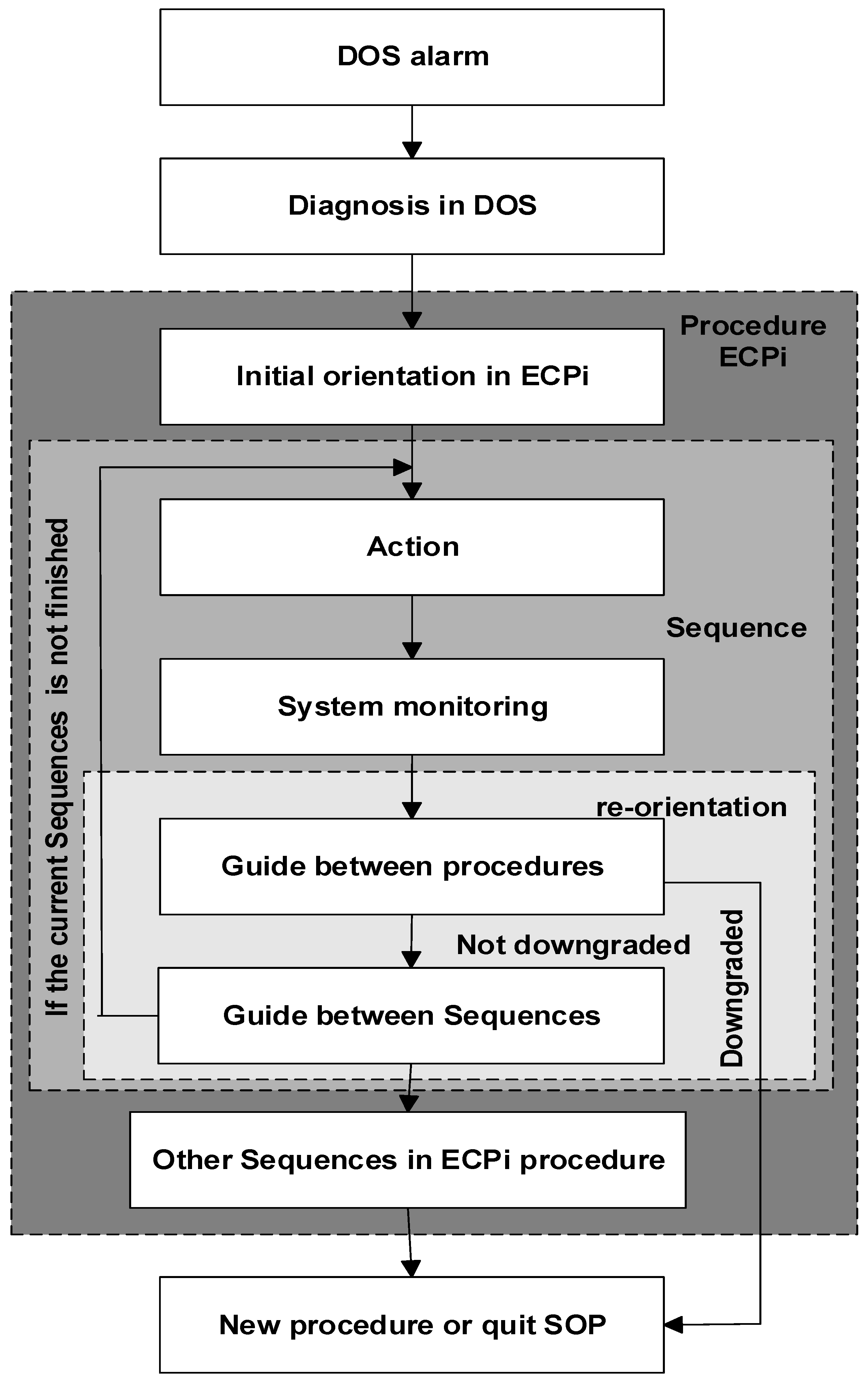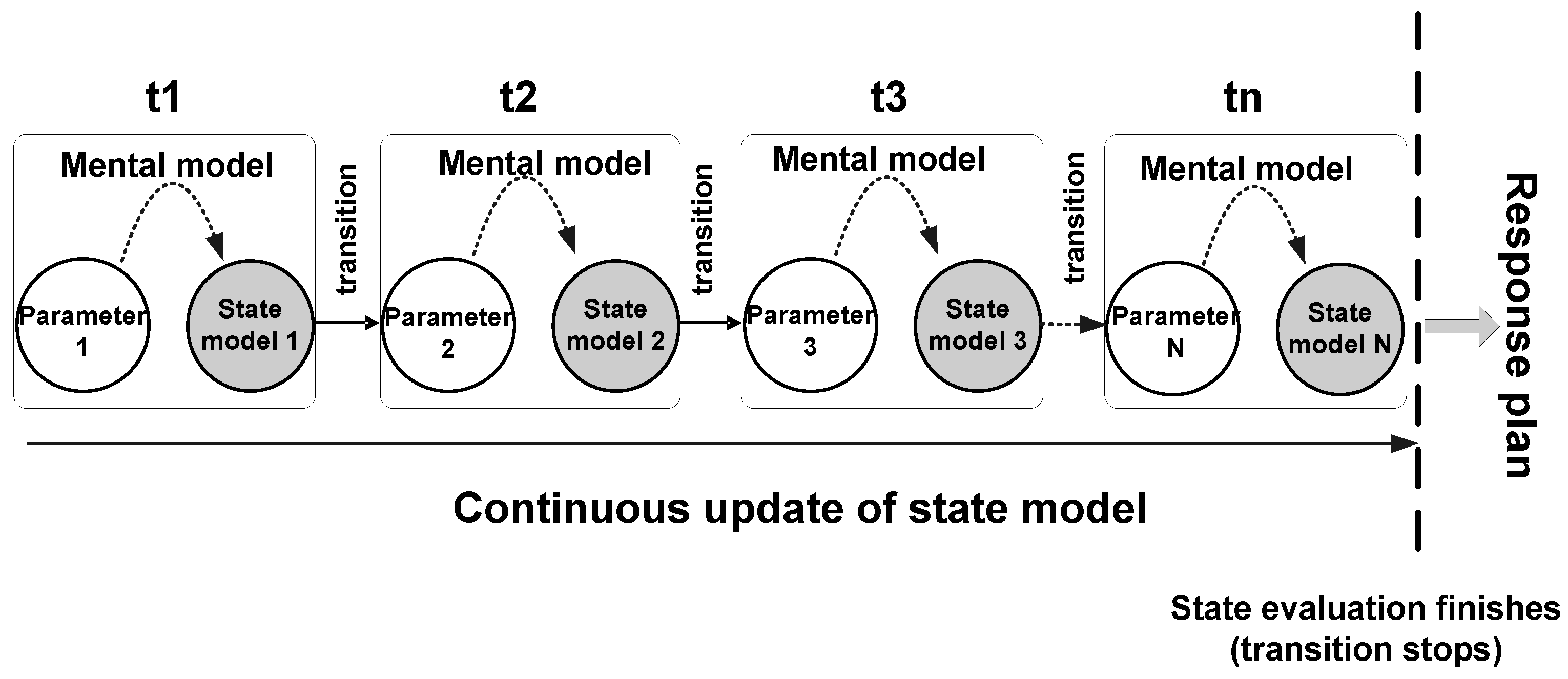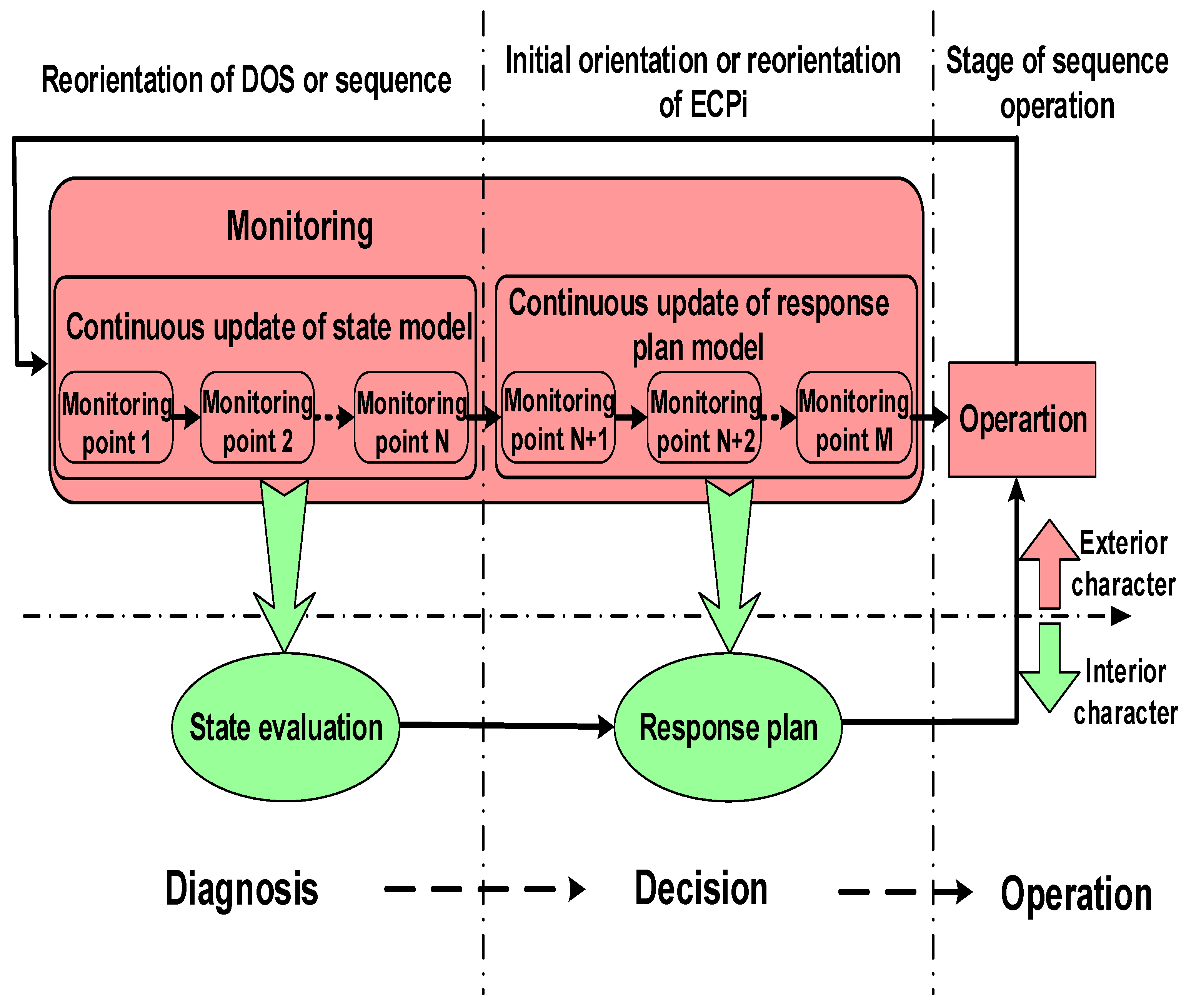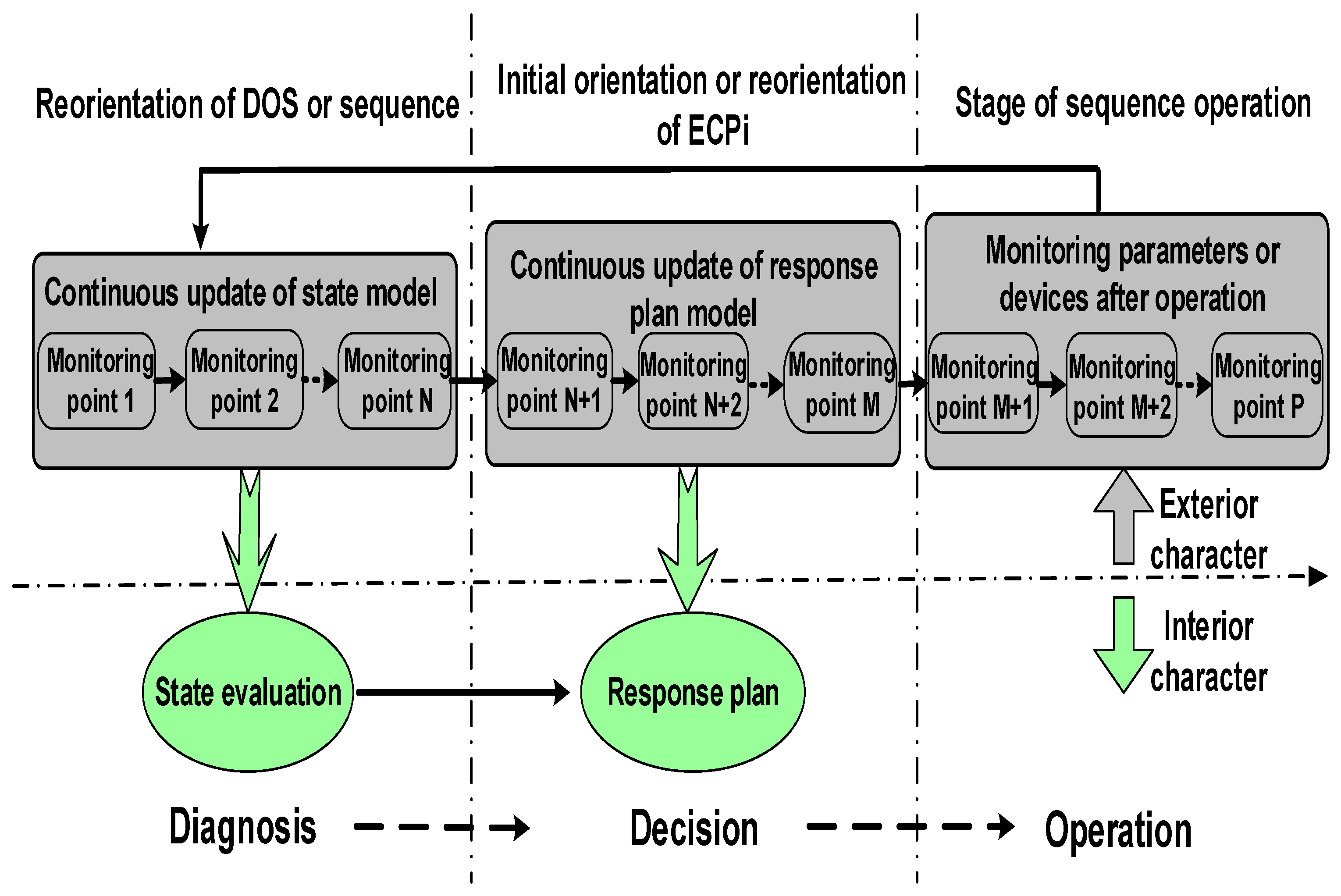Cognitive Behavioral Model of an Operation Crew in the Main Control Room of a Nuclear Power Plant Based on a State-Oriented Procedure
Abstract
:1. Introduction
2. Experiment
2.1. Introduction to the SOP
2.2. Human Cognitive Behavioral Process
3. Results and Conclusions
3.1. Operator Behavior
3.1.1. Diagnosis Phase
3.1.2. Decision Phase
3.1.3. Operation Phase
3.2. Coordinator Behavior
3.3. Team Cognitive Behavioral Model
- (1)
- Upon finishing diagnosis in the DOS, the RO needs to report to the US. For instance, when the operator completes diagnosis and enters an ECPi, the coordinator matches the result of the execution of the procedure to it. If the coordinator enters a different ECPi, either of the two could be subject to a diagnosis fault. Therefore, diagnosis for the accident needs to be conducted again to ensure a more reliable team response.
- (2)
- Upon reaching an ECPi decision, the RO must report to the US. The monitoring and warding process is the same as the above-mentioned one.
- (3)
- After the RO’s operations finish, the US monitors the results of these operations. The coordinator examines whether the required operations have been completed. Such an examination is usually carried out by checking whether the relevant controls are in the state of post-operation in the operator’s workstation.
4. Conclusions
Author Contributions
Funding
Institutional Review Board Statement
Informed Consent Statement
Data Availability Statement
Conflicts of Interest
References
- Stanton, N. (Ed.) Human Factors in Nuclear Safety, 1st ed.; Taylor & Francis Ltd.: London, UK, 1996. [Google Scholar]
- Senders, J.W.; Moray, N.P. (Eds.) Human Error: Cause, Prediction, and Reduction; CRC Press: Boca Raton, FL, USA, 2020. [Google Scholar]
- Bieder, C.; Bot, P.L.; Desmares, E.; Bonnet, J.L.; Cara, F. (Eds.) MERMOS: EDF’s New Advanced HRA Method. In Proceedings of the 4th International Conference on Probabilistic Safety Assessment and Management, New York, NY, USA, 13–18 September 1998; pp. 86–294. [Google Scholar]
- Song, J.; Liu, Y.; Shao, J.; Tang, C. A dynamic membership data aggregation (DMDA) protoco for smart grid. IEEE Syst. J. 2020, 14, 900–908. [Google Scholar] [CrossRef]
- Lv, Z.; Xiu, W. Interaction of edge-cloud computing based on SDN and NFV for next generation IoT. IEEE Internet Things J. 2019, 7, 5706–5712. [Google Scholar] [CrossRef]
- Lv, Z.; Song, H. Mobile internet of things under data physical fusion technology. IEEE Internet Things J. 2019, 7, 4616–4624. [Google Scholar] [CrossRef]
- Dean, S.; Mansoori, G.; Soelaiman, T.F. Nanotechnology—An introduction for the standards community. J. ASTM Int. 2005, 2, 1–22. [Google Scholar] [CrossRef] [Green Version]
- Samer, B.; Muhammad, A.; Tiziano, T.; Marco, C.; Flavio, R. The history of nanoscience and nanotechnology: From chemical-physical applications to nanomedicine. Molecules 2019, 25, 112. [Google Scholar]
- Lv, X.; Li, N.; Xu, X.; Yang, Y. Understanding the emergence and development of online travel agencies: A dynamic evaluation and simulation approach. Internet Res. 2020, 30, 1783–1810. [Google Scholar] [CrossRef]
- Lv, Z.; Qiao, L. Deep belief network and linear perceptron based cognitive computing for collaborative robots. Appl. Soft Comput. 2020, 92, 106300. [Google Scholar] [CrossRef]
- Yu, D.; Zhu, H.; Han, W.; Holburn, D. Dynamic multi agent-based management and load frequency control of PV/fuel cell/ wind turbine/CHP in autonomous microgrid system. Energy 2019, 173, 554–568. [Google Scholar] [CrossRef]
- Authen, S.; Holmberg, J.-E. Reliability analysis of digital systems in a probabilistic risk analysis for nuclear power plants. Nucl. Eng. Technol. 2012, 44, 471–482. [Google Scholar] [CrossRef] [Green Version]
- Kim, I.S. Human reliability analysis in the man-machine interface design review. Ann. Nucl. Energy 2001, 28, 1069–1081. [Google Scholar] [CrossRef]
- Swain, A.D. Human analysis: Need, status, trends and limitation. Reliab. Eng. Syst. Saf. 1990, 29, 301–313. [Google Scholar] [CrossRef]
- Hollnagel, E. Reliability analysis and operator modeling. Reliab. Eng. Syst. Saf. 1996, 52, 327–337. [Google Scholar] [CrossRef]
- Gertman, D.; Blackman, H.; Marble, J.; Byers, J.; Smith, C. (Eds.) The SPAR-H Human Reliability Analysis Method. In Proceedings of the Fourth American Nuclear Society International Topical Meeting on Nuclear Plant Instrumentation, Controls and Human-Machine Interface Technologies (NPIC & HMIT 2004), Columbus, OH, USA, 19–22 September 2005; pp. 446–460. [Google Scholar]
- Zhang, L. (Ed.) Human Reliability Analysis Technique in Probabilistic Safety Assessment; Atomic Energy Press: Beijing, China, 2006. [Google Scholar]
- He, L.; Chen, Y.; Zhao, H.; Tian, P.; Xue, Y.; Chen, L. Game-based analysis of energy-water nexus for identifying environmental impacts during shale gas operations under stochastic input. Sci. Total. Environ. 2018, 627, 1585–1601. [Google Scholar] [CrossRef]
- Zhang, W. Parameter adjustment strategy and experimental development of hydraulic system for wave energy power generation. Symmetry 2020, 12, 711. [Google Scholar] [CrossRef]
- Cao, Y.; Wang, Q.; Fan, Q.; Nojavan, S.; Jermsittiparsert, K. Risk-constrained stochastic power procurement of storage-based large electricity consumer. J. Energy Storage 2020, 28, 101183. [Google Scholar] [CrossRef]
- Simos, T.E.; Tsitouras, C. Explicit, Ninth Order, Two Step Methods for Solving Inhomogeneous Linear Problems X ‘‘(T) = Lambda X(T) Plus F(T). Appl. Numer. Math. 2020, 4, 92–101. [Google Scholar] [CrossRef]
- U.S. Nuclear Regulatory Commission (Ed.) Technical Basis and Implementation Guidelines for a Technique for Human Event Analysis (ATHEANA). NUREG-1624, Rev. 1; US Nuclear Regulatory Commission: Washington, DC, USA, 2007.
- Hollnagel, E. Human reliability assessment in context. Nucl. Eng. Technol. 2005, 37, 159–166. [Google Scholar]
- Chang, Y.J.; Bley, D.; Criscione, L.; Kirwan, B.; Mosleh, A.; Madary, T.; Nowell, R.; Richards, R.; Roth, E.M.; Sieben, S.; et al. The SACADA database for human reliability and human performance. Reliab. Eng. Syst. Saf. 2014, 125, 117–133. [Google Scholar] [CrossRef]
- Zhou, P.; Fan, Q.; Zhu, J. Empirical Analysis on Environmental Regulation Performance Measurement in Manufacturing Industry: A Case Study of Chongqing, China. Appl. Math. Nonlinear Sci. 2020, 5, 25–34. [Google Scholar] [CrossRef]
- Durur, H.; Kurt, A.; Tasbozan, O. New Travelling Wave Solutions for KdV6 Equation Using Sub Equation Method. Appl. Math. Nonlinear Sci. 2020, 5, 455–460. [Google Scholar] [CrossRef]
- Erik, H. (Ed.) Cognitive Reliability and Error Analysis Method; Elsevier Science Ltd.: Oxford, UK, 1998. [Google Scholar]
- Di Nardo, M.; Murino, T. The System Dynamics in the Human Reliability Analysis Through Cognitive Reliability and Error Analysis Method: A Case Study of an LPG Company. Int. Rev. Civ. Eng. (IRECE) 2021, 12, 56. [Google Scholar] [CrossRef]
- Forester, J.A.; Dang, V.N.; Bye, A.; Boring, R.L.; Lois, E. (Eds.) Conclusions on Human Reliability Analysis (HRA) Methods from the International HRA Empirical Study. In Proceedings of the 11th International Probabilistic Safety Assessment and Management Conference (PSAM11) and the Annual European Safety and Reliability Conference (ESREL 2012), Helsinki, Finland, 25–29 June 2012; pp. 318–331. [Google Scholar]
- Lee, S.W.; Kim, A.R.; Ha, J.S.; Seong, P.H. Development of a qualitative evaluation framework for performance shaping factors (PSFs) in advanced MCR HRA. Ann. Nucl. Energy 2011, 38, 1751–1759. [Google Scholar] [CrossRef]
- Lüdtke, A. (Ed.) Kognitive Analyse Formaler Sicherheitskritischer Steuerungssysteme auf Basis eines integrierten Mensch-Maschine-Models; Akademische Verlagsgesellschaft Aka GmbH: Berlin, Germany, 2005. [Google Scholar]
- Mosleh, A.; Chang, Y. Model-based human reliability analysis: Prospects and requirements. Reliab. Eng. Syst. Saf. 2004, 83, 241–253. [Google Scholar] [CrossRef]
- Medvedeva, M.A.; Simos, T.E.; Tsitouras, C. Exponential Integrators for Linear Inhomogeneous Problems. Math. Methods Appl. Sci. 2020, 44, 937–944. [Google Scholar] [CrossRef]
- Chang, Y.J.; Mercurio, D.; Dang, V.; Mosleh, A. (Eds.) Recent Developments and Insights from Application of ADS-IDAC Dynamic PRA Platform. In Proceedings of the Probabilistic Safety Assessment and Management (PSAM 9) Conference, Hong Kong, China, 18–23 May 2008; pp. 181–190. [Google Scholar]
- O’Hara, J.M.; Higgins, J.C.; Stubler, W.F.; Kramer, J. Computer-Based Procedure System: Technical Basis and Human Factors Review Guidance. NUREG/CR-6634; US Nuclear Regulatory Commission: Washington, DC, USA, 2002.







Publisher’s Note: MDPI stays neutral with regard to jurisdictional claims in published maps and institutional affiliations. |
© 2022 by the authors. Licensee MDPI, Basel, Switzerland. This article is an open access article distributed under the terms and conditions of the Creative Commons Attribution (CC BY) license (https://creativecommons.org/licenses/by/4.0/).
Share and Cite
Qing, T.; Liu, Z.; Zhang, L.; Tang, Y.; Hu, H.; Chen, S. Cognitive Behavioral Model of an Operation Crew in the Main Control Room of a Nuclear Power Plant Based on a State-Oriented Procedure. Processes 2022, 10, 182. https://doi.org/10.3390/pr10020182
Qing T, Liu Z, Zhang L, Tang Y, Hu H, Chen S. Cognitive Behavioral Model of an Operation Crew in the Main Control Room of a Nuclear Power Plant Based on a State-Oriented Procedure. Processes. 2022; 10(2):182. https://doi.org/10.3390/pr10020182
Chicago/Turabian StyleQing, Tao, Zhaopeng Liu, Li Zhang, Yaqin Tang, Hong Hu, and Shuai Chen. 2022. "Cognitive Behavioral Model of an Operation Crew in the Main Control Room of a Nuclear Power Plant Based on a State-Oriented Procedure" Processes 10, no. 2: 182. https://doi.org/10.3390/pr10020182
APA StyleQing, T., Liu, Z., Zhang, L., Tang, Y., Hu, H., & Chen, S. (2022). Cognitive Behavioral Model of an Operation Crew in the Main Control Room of a Nuclear Power Plant Based on a State-Oriented Procedure. Processes, 10(2), 182. https://doi.org/10.3390/pr10020182





